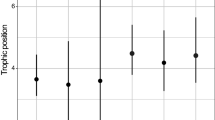Abstract
Omnivory can have profound effects on the trophic dynamics of communities and ecosystems, as they may interact with multiple trophic levels simultaneously. Some species of large-bodied stoneflies may be viewed as omnivores rather than true carnivores even at later nymphal stages. We evaluated the seasonal change in the diet of stonefly predators by analyzing their stable isotope ratio, gut contents, physiological activity, and food availability. A two-source-based mixing model based on stable isotope analysis revealed that stoneflies shifted their diet between carnivory in summer and omnivory in winter—despite the higher availability of animal prey in winter. The gut content analysis showed that swift prey (mayflies) were consumed in the summer, whereas sluggish prey (Chironomidae) were consumed in the winter. The physiological activity of stoneflies also declined markedly in winter. These results suggest that, in winter, stoneflies foraged on a mixture of Chironomidae and algae. It appears that omnivory in some stream consumers is related to the seasonal change in temperature-dependent physiological activity, rather than prey availability.




Similar content being viewed by others
References
Allan JD (1982) Feeding habits and prey consumption of three setipalpian stoneflies (Plecoptera) in a mountain stream. Ecology 63:26–34
Buchholz F, Saborowski R (2000) Metabolic and enzymatic adaptations in northern krill, Meganyctiphanes norvegica, and Antarctic krill, Euphausia superba. Can J Fish Aquat Sci 57:115–129
Charnov EL (1976) Optimal foraging: attack strategy of a mantid. Am Nat 110:141–151
Feminella JW, Stewart KW (1986) Diet and predation by three leaf-associated stoneflies (Plecoptera) in an Arkansas mountain stream. Freshw Biol 16:521–538
Genkai-Kato M, Carpenter SR (2005) Eutrophication due to phosphorus recycling in relation to lake morphometry, temperature, and macrophytes. Ecology 86:210–219
Genkai-Kato M, Miyasaka H (2007) Length–weight relationships of four predatory species in Japan. Limnology 8:171–174
Genkai-Kato M, Nozaki K, Mitsuhashi H, Kohmatsu Y, Miyasaka H, Nakanishi M (2000) Push-up response of stonefly larvae in low-oxygen conditions. Ecol Res 15:175–179
Genkai-Kato M, Mitsuhashi H, Kohmatsu Y, Miyasaka H, Nozaki K, Nakanishi M (2005) A seasonal change in the distribution of a stream-dwelling stonefly nymphs reflects oxygen supply and water flow. Ecol Res 20:223–226
Herrel A, Vanhooydonck B, Van Damme R (2004) Omnivory in lacertid lizards: adaptive evolution or constraint? J Evol Biol 17:974–984
Hynes HBN (1970) The ecology of running waters. Liverpool University Press, Liverpool
Kishi D, Murakami M, Nakano S, Maekawa K (2005) Water temperature determines strength of top-down control in a stream food web. Freshw Biol 50:1315–1322
Lancaster J, Bradley DC, Hogan A, Waldron S (2005) Intraguild omnivory in predatory stream insects. J Anim Ecol 74:619–629
Maruyama A, Yamada Y, Rusuwa B, Yuma M (2001) Change in stable nitrogen isotope ratio in the muscle tissue of a migratory goby, Rhinogobius sp., in a natural setting. Can J Fish Aquat Sci 58:2125–2128
McCann KS, Hastings A, Huxel GR (1998) Weak trophic interactions and the balance of nature. Nature 395:794–798
Merritt RW, Cummins KW (1996) An introduction to the aquatic insects of North America. Kendall-Hunt, Dubuque
Miyasaka H, Genkai-Kato M (2007) Accuracy assessment for chlorophyll a measurements in the gut of stream stonefly nymphs. In: Tanabe S, Takeoka H, Isobe T, Nishibe Y (eds) Chemical pollution and environmental changes. Universal Academy Press, Tokyo, pp 335–338
Peters RH (1983) The ecological implications of body size. Cambridge University Press, New York
Pimm SL, Lawton JH (1978) On feeding on more than one trophic level. Nature 275:542–544
Taniguchi Y, Nakano S (2000) Condition-specific competition: implications for the altitudinal distribution of stream fishes. Ecology 81:2027–2039
Unesco (1966) Determination of photosynthetic pigments in sea-water. In: United Nations Educational, Scientific and Cultural Organization (ed) Monographs on oceanographic methodology. Unesco Press, Paris
Vadeboncoeur Y, McCann KS, Vander Zanden MJ, Rasmussen JB (2005) Effects of multi-chain omnivory on the strength of trophic control in lakes. Ecosystems 8:682–693
Vander Zanden MJ, Rasmussen JB (1999) Primary consumer δ15N and δ13C and the trophic position of aquatic consumers. Ecology 80:1395–1404
Vander Zanden MJ, Rasmussen JB (2001) Variation in δ15N and δ13C trophic fractionation: implications for aquatic food web studies. Limnol Oceanogr 46:2061–2066
Werner EE, Gilliam JF (1984) The ontogenetic niche and species interaction in size-structured populations. Ann Rev Ecol Syst 15:393–425
Zeng N, Neelin JD, Lau KM, Tucker CJ (1999) Enhancement of interdecadal climate variability in the Sahel by vegetation interaction. Science 286:1537–1540
Acknowledgments
We are grateful to A.R. McIntosh, J. Urabe, M.J. Vander Zanden and T.W. Miller for their comments on the manuscript. We thank K. Nozaki for identifying algal species. H. Mitsuhashi and Y. Kohmatsu helped with the field survey. This research was partly supported by the 21st COE Program at Ehime University, the Foundation of River and Watershed Environmental Management of Japan, and the Japan Society for the Promotion of Science.
Author information
Authors and Affiliations
Corresponding author
Appendices
Appendix 1
Appendix 2
About this article
Cite this article
Miyasaka, H., Genkai-Kato, M. Shift between carnivory and omnivory in stream stonefly predators. Ecol Res 24, 11–19 (2009). https://doi.org/10.1007/s11284-008-0475-3
Received:
Accepted:
Published:
Issue Date:
DOI: https://doi.org/10.1007/s11284-008-0475-3




